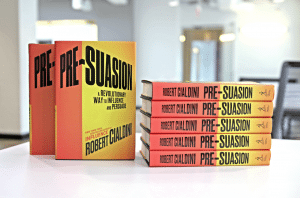 Reader Question: I’m Presentation Designer with a main focus on Pitch Decks (investor decks), working on a freelance basis. My prime source for finding new clients was Upwork, but recently I’ve decided to “quit it.” So, I’ve created a personal website with landing page where I describe and show samples of my service. Now, the question is how do I promote my website to find new clients? I’m thinking about paid ads and perhaps using Medium (writing a few interesting articles on pitch deck design). Do you think writing cold emails directly to venture funds and startup incubators can also help?
Reader Question: I’m Presentation Designer with a main focus on Pitch Decks (investor decks), working on a freelance basis. My prime source for finding new clients was Upwork, but recently I’ve decided to “quit it.” So, I’ve created a personal website with landing page where I describe and show samples of my service. Now, the question is how do I promote my website to find new clients? I’m thinking about paid ads and perhaps using Medium (writing a few interesting articles on pitch deck design). Do you think writing cold emails directly to venture funds and startup incubators can also help?
Olga’s Answer: I think a lot of freelancers cross this bridge sooner or later: How do I make the jump from platform to personal? How do I go from working within a system to being a free agent?
I’m not sure why you’re planning on “quitting” Upwork. I can only guess that you’re not getting the caliber of clients or hourly fees you’re hoping for. So, first off, I have to ask: What are you hoping to accomplish outside of Upwork that you can’t accomplish on that platform? Once you’ve answered the quitting upwork question, we can move on.
Obviously, you need to have a solid, attractive website with your portfolio and samples of your work. It doesn’t hurt to have a video, too. That all goes without saying. But, then, (and perhaps more importantly) you have to separate out your home base from the methods you choose to promote it. You want people to find you through Google, LinkedIn, Facebook, Twitter, YouTube, Medium, and other avenues, but ultimately, you need a unified place for them to come and find out all about you.
Since pitch decks are your jam, I’d start out on LinkedIn with Slideshare to show off your work. Then, you can promote your decks through the LinkedIn publishing platform. Write articles on “how to” to create great decks and share them on LinkedIn.
As far as “cold calling” emails go, you need to really focus on who will be hiring you. Then, find out where they hang out. Go where your target is. Then, ask yourself if there are there other professionals you can team up with to pitch to the same people? Combine efforts and increase your impact.
Of course, the delivery is nothing, really, without a solid message.
 I recently came across a promo for a new book, “Pre-Suasion: A Revolutionary Way to Influence and Persuade,” in which Robert Cialdini explains that we need to take a 2500-year-old tip from good ol’ Sun Tzu: “Every battle is won before it is fought.” It’s all about what you do before you try to persuade someone. The book advises, “The best persuaders become the best through pre-suasion—the process of arranging for recipients to be receptive to a message before they encounter it.”
I recently came across a promo for a new book, “Pre-Suasion: A Revolutionary Way to Influence and Persuade,” in which Robert Cialdini explains that we need to take a 2500-year-old tip from good ol’ Sun Tzu: “Every battle is won before it is fought.” It’s all about what you do before you try to persuade someone. The book advises, “The best persuaders become the best through pre-suasion—the process of arranging for recipients to be receptive to a message before they encounter it.”
So, you need to think about first answering my favorite question: “Why choose you?” I’m already making the assumption that if there were five other kick-ass presentation designers in the room, that you would stand out, and be the best. But why? It may be useful at this point to review my musings on Unique Value Proposition and how to tie in your “-EST”s (i.e. best features) with specific benefits. You make pitch decks, for crying out loud, so it’s high time to make one about choosing YOU.
I’m also making the assumption that you’ve done your homework and VCs and startup incubators are your exact target. In the Los Angeles area, where I live, there are dozens of in-person events, both more casual meet ups and sponsored larger events, where you can walk into a room of prospective clients. How would you get their attention IRL?
 There are also dozens of online platforms, like Founder Dating, LinkedIn groups, and Medium.com Locals, that have active communities. There, you can show off your skills by helping community members. Are you willing to give of your fabulous talents? Do so, then, get them to recommend you…and, voila, you’ve answered why others in those communities should choose you first.
There are also dozens of online platforms, like Founder Dating, LinkedIn groups, and Medium.com Locals, that have active communities. There, you can show off your skills by helping community members. Are you willing to give of your fabulous talents? Do so, then, get them to recommend you…and, voila, you’ve answered why others in those communities should choose you first.
In summary, when you go from using a platform to doing it on your own, you need a solid home base (the equivalent of an online storefront). Then, the big battle is getting somebody there. So, start thinking like your target. What are they looking for and where are they looking? Then, focus on being in those places visibly, as the go-to guy to ask –whether that’s in person, online, or through various forms of advertising.


